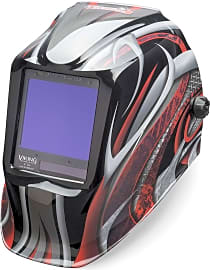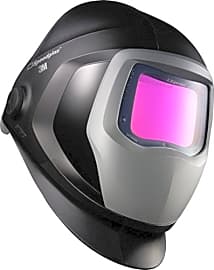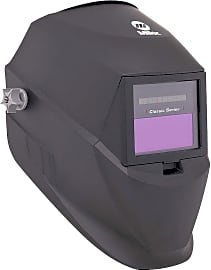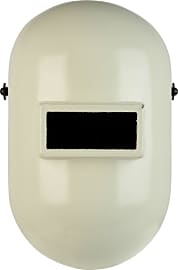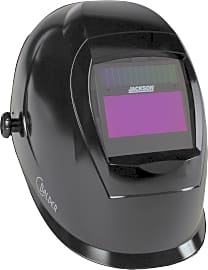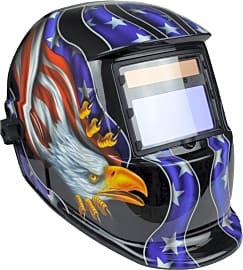The 10 Best Welding Helmets

This wiki has been updated 40 times since it was first published in March of 2015. If you are a MIG, TIG or arc welder, one of the welding helmets from our comprehensive selection will be perfect for your next project, whether that's DIY or professional. These are necessary to protect you from burns and harmful UV rays. We've ranked them according to reaction time, the size of the viewing area, how easily they can be customized to your specific needs, and overall user comfort. When users buy our independently chosen editorial recommendations, we may earn commissions to help fund the Wiki.
Editor's Notes
March 10, 2021:
As the most essential item of personal protection a welder can have, a high-quality welding helmet, often referred to as a 'hood', not only protects the skin from sparks and burns, but it also protects the eyes from vision damaging ultraviolet and infrared rays that are emitted by the arc. They are suitable for a range of welding styles, most commonly MIG, TIG, and MMA, and in some cases plasma too. In this update, we added several new helmets to the ranking with modern features and improved safety.
Most of the helmets here feature auto-darkening screens, with the exception of the Honeywell Piperliner, which is a no-frills option that is notable for its compact size. We included the Tooliom Clamshell in the list due to its unique, flip-up visor, which allows simple transition from welding tasks. It features an auto-darkening, true color lens with a 3.64 by 1.67-inch viewing area, and when lifted a large clear screen allows other tasks to be completed while still providing necessary eye and skin protection. Also included is the Yesweldes Panoramic, which boasts a 180-degree field of view thanks to its twin side windows, giving a total of three LCD Screens that can work both independently and synchronously. It also features three auto-darkening view filters with six sensors, and a 3,000-hour battery life, making it an ideal choice for professionals.
July 08, 2019:
Auto-darkening welding helmets have become absolutely essential for welding. Before their advent, welders would typically go through a training period characterized by excruciating eye pain(many still do). The problem was that you had to place your welding hand(s) right at the workpiece, then manually flip your helmet down, then your welding hand would inevitably move and you would be forced to flip your helmet back up to reposition because you can't see anything through a standard welding lens until there is an arc. Often, instead of following safety protocol, you would start the welding process and then flip your helmet down. This exposed retinas to UV rays that would add up over the course of a work-day. Then in the middle of the night, you wake up and feel like someone rubbed sand in your eyes. This extreme pain lasts hours. Thanks to auto-darkening helmets like the Lincoln Electric Twisted Metal, the 3M SpeedGlas 9100, and the Miller Electric 251292, this can be avoided.
Welding involves using high voltages to melt metal which creates a risk of shock and burns. Welding should only be performed by trained welders to prevent personal injury or death.
Special Honors
Black Stallion Once you have a chosen suitable helmet, you will also need to invest in safety equipment for the rest of your body. Black Stallion provides a comprehensive range of necessary protective wear for use while welding, such as gloves, bibs, jackets, and neck gaiters. blackstallion.com
Sentinel A50 Bringing next-level technology to the welding helmet, the A50 features a streamlined design with a spherical front lens cover that allows more light to get in while in grind mode. It also has a full-color LCD touchscreen with intuitive controls and easy-to-use functions. esabna.com
Brief History Of Welding
Throughout the Middle ages, people became incredibly skilled in forge welding and produced a number of impressive metal works.
The earliest form of welding is known as forge welding. It is a process by which blacksmiths continuously pound red hot metal until it binds together. Evidence of forge welding has been found dating all the way back to the bronze age. There is a written account from the 5th century BCE by Herodotus, an ancient Greek historian, that states Glaucus of Chios invented welding.
It is also known that welding was used during construction of the Iron Pillar of Delhi, which took place in 310 CE. While it is not known exactly when welding made its first debut in human history, all accounts show that it is truly an ancient craft.
Throughout the Middle ages, people became incredibly skilled in forge welding and produced a number of impressive metal works. In 1540, De la Pirotechnia, an in-depth book on metallurgy was published and it included a detailed section of the process of forging and forge welding.
It wasn't until the 19th century that welding began to modernize into the forms that are often employed today. The discovery of the short-pulse electrical arc in 1800 by Sir Humphry Davy, was the first step. The short-pulse electrical arc soon led to the continuous electrical arc, which is the basis for arc welding. In 1881, two inventors working together, Stanislaw Olszewski and Nikolai Benardos created the first electrical arc weld using carbon electrodes.
During the last decades of the 19th century and the first decades of the 20th century, a number of new welding methods were developed. 1885 saw the advent of resistance welding, and in 1893, oxyfuel welding and thermite welding established themselves. Alternating current welding was invented in 1919, by C.J. Holsag, and roughly a decade later it become a popular method for creating welds.
In the middle of the 20th century, a number of other welding techniques were developed. In 1930, stud welding and submerged arc welding were invented. Just a decade later in 1941, tungsten arc welding was perfected. It was followed seven short years later by gas metal arc welding, and in the 1950s, shielded metal arc welding was developed. Over the next 50 years, new welding techniques and methods continued to be improved upon and discovered, with the most recent breakthrough being the invention of friction stir welding in 1991.
Common Welding Techniques
There are many forms of welding currently in use today, but three stand out as the most popular methods. Shielded metal arc welding, more commonly referred to as stick welding, is the most basic form. It utilizes an electrode, in the shape of a welding rod, to carry an electrical current and provide the majority of the weld material.
Since the electrode is not consumed, it creates autogenous welds and relies on molten puddles from the two metal objects being welded together to form the weld.
As the welding rod is touched to and withdrawn from the surface to be welded, an electrical arc instantly produces temperatures of over 6,000°F, which melt the welding rod and the base metal to create the weld. Stick welding can be performed with as little as a car battery, jumper cables, and an electrode.
Gas metal arc welding, commonly referred to as metal inert gas or MIG welding, is considered the most easily mastered welding method and is also the most common for industrial applications. It also makes use of an electrode, which is continuously fed through a welding gun, and an arc to create welds. It is called gas metal arc welding because it utilizes an externally supplied shielding gas to protect the molten weld metal from nitrides and oxides in the atmosphere.
When one must weld together extremely thick stainless steel or nonferrous metals, the best method is gas tungsten arc welding, which is commonly referred to as tungsten inert gas or TIG welding. TIG welding makes use of a tungsten electrode and is a more complex and time consuming technique requiring more expertise from the welder.
In TIG welds, the electrode is not consumed, as it is with other arc weld methods, and it can be used to create cleaner welds which need less finishing work. Since the electrode is not consumed, it creates autogenous welds and relies on molten puddles from the two metal objects being welded together to form the weld. It also makes use of a shielding gas to protected the molten weld from nitrides and oxides in the atmosphere.
Protecting Offered By Welding Helmets
Welding helmets are designed to be worn over the head and in front of the face when performing welds. The majority feature some kind of headband and can be flipped up over the head when it is time to closely inspect the weld, or if the user needs to hold a conversation or look for tools. When welding, it can easily be flipped down to protect the eyes, face, and neck.
Welding helmets are necessary to prevent flash burns to the skin and block the user from heat or ultraviolet light produced during the welding process. They can also prevent a painful condition known as photokeratitis. This is a condition in which the cornea becomes inflamed from the ultraviolet radiation created during arc welding. Most often, a welder will not realize their level of exposure until several hours after welding has completed and the pain begins.
The intense flashes of ultraviolet light and infrared rays welding produces can also burn the retina and cause vision loss over time. In addition to burning the retina, the ultraviolet emissions can also damage exposed skin and cause burns akin to what happens when a person is over exposed to the sun. When used properly, welding helmets can prevent all of these injuries.


